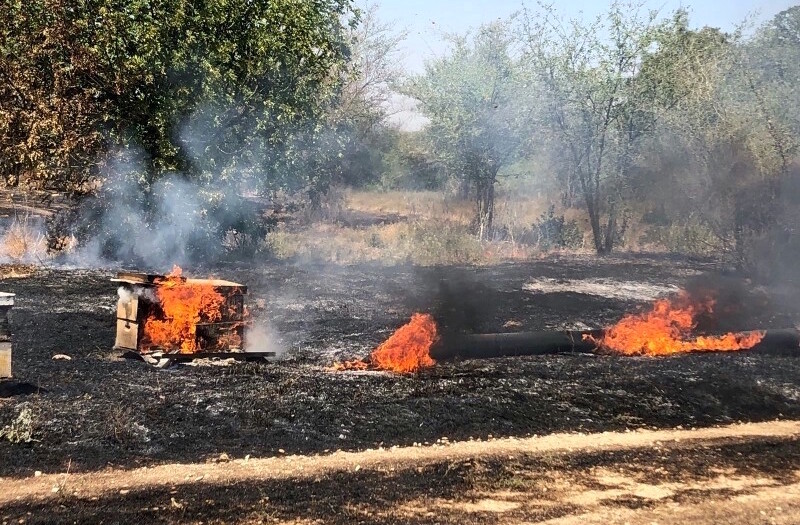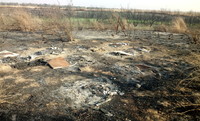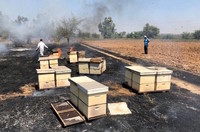Fire kites sting honey farms before Rosh Hashanah
When you drive into Israel’s Sha’ar HaNegev Region in the northwestern Negev, the fields are burnt and black. The trees are broken, and the smell of acrid smoke stings the eyes and nose.
“It is a very upsetting view,” said Zeev Meidan, manager of the Israeli Honey Council.
Meidan, once employed as a beekeeper at the area’s Kibbutz Yad Mordechai, has been spending extra time in the southern district to support the region’s honey farmers, many of whom have been the target of arson attacks by Hamas.
He said arson in the Gaza periphery via flammable kites and helium balloons has caused millions of shekels in damage to the beehives of Kibbutz Erez and Yad Mordechai in the period before Rosh Hashanah, the height of the honey harvest. On average, Meidan said, hives would produce as much as 50 kilograms of honey each.
“After many months of labor, we were supposed to collect the honey from our hives,” said Boaz Kanot, chairman of the Israel Beekeepers Association. “The recent fires have burned dozens of beehives full of honey just before it was meant to be packaged and distributed. This is a huge loss.”
Many beekeepers rely on income from this season to support themselves throughout the year, explained Yitzchak “Hakale” Amitai, manager of Kibbutz Erez’s building and infrastructure. He said beekeepers’ taxes go to the kibbutz, which will also suffer a financial blow.
The government has committed to help offset the loss, but only about half of the funds have been transferred thus far, said Meidan.
Amitai said the beehives are not located in the kibbutzim, but in open land around them. In addition to the bees themselves being scorched, the remaining bees cannot produce honey because there are no flowers on which to graze.
“Flowers do not grow overnight, so in the near future there will not be enough flowers to make honey,” he said. Fewer bees also mean “that they will not be able to pollinate the fields.”
‘Nearly all the grove was burnt’
According to Meidan, Israel produces 3,500 tons of honey per year; little or none is exported. It imports about 1,000 tons of honey, which together with local production just meets the needs of Israelis, especially around the holidays. He said Israel’s northern farmers and imports this year should make up for the loss in the Sha’ar HaNegev Region, and prices should remain stable through the High Holidays and Sukkot.
Meidan said Israel has around 120,000 beehives, 5,000 near the Gaza border. Of those, some 200 have been destroyed and thousands more impacted by the fires. While annual plants can be regrown with little impact on next year’s honey season, he explained, other varietals, like eucalyptus trees, cannot be grown in a year. As such, there will be long-term impact on the industry that has yet to be determined.
The situation has taken an emotional toll.
“It is terrible to watch your hives burn up alongside eucalyptus trees, flowers and grazing land,” said beekeeper Ido Eden. “Nearly all the grove was burnt, and with it, my hives ... I was planning to go on vacation with my family, but now I’m not so sure. It just feels terrible.”
‘It is not only hurting the Jews’
Yahel Ben-Aris, volunteer coordinator for the MetroWest New Jersey Federation-Kibbutz Erez partnership, expressed similar sentiments.
“You just look out at the fields and see fire — another kite, another balloon — it’s crazy. It doesn’t make sense.”
Ben-Aris lives in Kibbutz Erez. He said there are at least six fires a week, sometimes three a day. The kibbutz has put together a firefighting team with equipment purchased largely from donations by the MetroWest New Jersey Federation. There is a constant need to replenish items like fire hoses, which are quickly worn down. Retirees from across the country have volunteered to sit in watchtowers monitoring aerial attacks.
Strikingly, even as their fields are destroyed and production frustrated, residents and leadership alike say they have empathy for the plight of the Gazans and do not want to go to war.
Sha’ar HaNegev Regional Council Mayor Alon Shuster told JNS that Gaza activists have set fires near the border for years. Now, kites and balloons extend their reach. While he said that the results are tragic economically, emotionally and agriculturally, “we are lucky none of the burning kites have put people in danger.” He doesn’t want military action to be the only solution.
“A war will just temporarily stop the fires, but it will not stop Hamas from attacking us again,” he said. “Of course, Hamas is a terrible partner for negotiations. … But we must move to a situation where Israel opens dialogue with Hamas — for the people of Israel and Gaza. While this is hard on us, the people in Gaza are suffering in ways we cannot even imagine or describe.”
Meidan added, “Hamas should know that not only does the arson not help them, it is not only hurting the Jews. It is bad for nature and killing bees, innocent insects that don’t deserve to die.”
He believes the people of the Sha’ar HaNegev Region are resilient. “We will not be broken.”
Ben-Aris said the first flowers that pop up as the land starts to heal are red anemones, which he said will revive the fields in vibrant color.
“It will be very pretty,” he said. “New life — that is the message I would send back to Hamas.”

 49.0°,
Fair
49.0°,
Fair 









